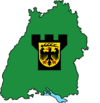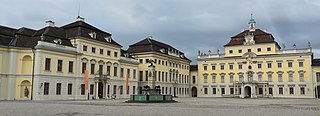
Ludwigsburg is a city in Baden-Württemberg, Germany, about 12 kilometres (7.5 mi) north of Stuttgart city centre, near the river Neckar. It is the largest and primary city of the Ludwigsburg district with about 88,000 inhabitants. It is situated within the Stuttgart Region, and the district is part of the administrative region (Regierungsbezirk) of Stuttgart.

Ludwigsburg Palace, nicknamed the "Versailles of Swabia", is a 452-room palace complex of 18 buildings located in Ludwigsburg, Baden-Württemberg, Germany. Its total area, including the gardens, is 32 ha – the largest palatial estate in the country. The palace has four wings: the northern wing, the Alter Hauptbau, is the oldest and was used as a ducal residence; the east and west wings were used for court purposes and housing guests and courtiers; the southern wing, the Neuer Hauptbau, was built to house more court functions and was later used as a residence.

Solitude Palace is a Rococo schloss and hunting retreat commissioned by Charles Eugene, Duke of Württemberg. It was designed by Johann Friedrich Weyhing and Philippe de La Guêpière, and constructed from 1764 to 1769. It is located on an elongated ridge between the towns of Leonberg, Gerlingen and Stuttgart in Baden-Württemberg.

The New Palace is an 18th-century Baroque palace in Stuttgart and is one of the last large city palaces built in Southern Germany. The palace is located in the on the Schlossplatz in front of the Jubiläumssäule column and Königsbau. Public tours of the building are only permitted by special arrangement, as the building contains some government offices. Once a historic residence of the Kings of Württemberg, the New Palace derives its name from its commissioning by Duke Carl Eugen of Württemberg to replace the Old Castle in the early years of his reign. Originally, Charles commissioned Nikolaus Friedrich Thouret, but architects Leopoldo Retti, Philippe de La Guêpière, Reinhard Heinrich Ferdinand Fischer would contribute to the design, history, and construction of the palace.

(Pierre Louis) Philippe de La Guêpière was an 18th-century French architect whose main commissions were from Karl Eugen, Duke of Württemberg.
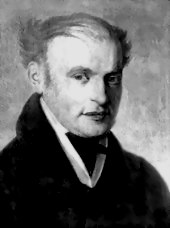
Nikolaus Friedrich von Thouret was a German architect and designer.
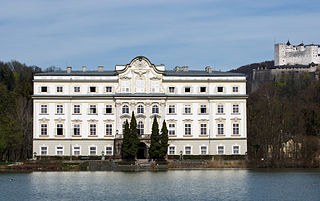
Schloss Leopoldskron is a rococo palace and a national historic monument in Leopoldskron-Moos, a southern district of the city of Salzburg, Austria. The palace, and its surrounding seven hectare park, is located on the lake Leopoldskroner Weiher. The palace has been home to Salzburg Global Seminar since 1947. In 2014, the palace and the neighboring Meierhof building were opened as a privately owned hotel, Hotel Schloss Leopoldskron.

The House of Württemberg is a German dynasty and former royal family from Württemberg.

The Old Palace is a former castle located on the Schillerplatz in Stuttgart, Germany. The castle, originally a water castle dating back to the 10th century, was the residence of the Counts and later some Dukes of Württemberg and today is the home of the Landesmuseum Württemberg. The castle church still functions as a place of worship.

Schloss Favorite is a Baroque maison de plaisance and hunting lodge in Ludwigsburg, Germany and was used as a summer residence and hunting lodge. It is located on a rise, directly north of Ludwigsburg Palace and connected via an avenue to it.

Schloss Favorite is a schloss on the outskirts of Rastatt-Förch in Baden-Württemberg, Germany.

Schloss Rastatt, also known as Residenzschloss Rastatt, is a Baroque schloss in Rastatt, Germany. The palace and the garden were built between 1700 and 1707 by the Italian architect Domenico Egidio Rossi for Margrave Louis William of Baden-Baden. Visitors can tour the restored Baroque interior and gardens.
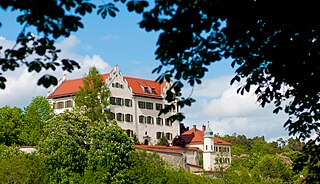
Schloss Duttenstein is a Renaissance hunting castle located near the village of Demmingen, which is part of the town of Dischingen in Baden-Württemberg in Germany.
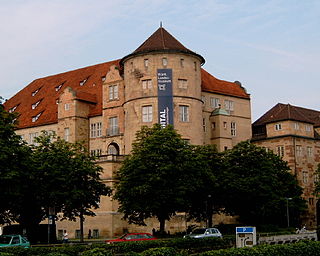
The Landesmuseum Württemberg is the main historical museum of the Württemberg part of the German state of Baden-Württemberg. It emerged from the 16th-century “Kunstkammer” of the dukes, later kings, of Württemberg who resided in Stuttgart. As a museum it was founded in 1862 by King William I.

In Renaissance and Early Modern German architecture, a Lustschloss is a small country house or palace which served the private pleasure of its owner, usually the ruler of the area it is located in, and was seasonally inhabited as a respite from court ceremonies and state duties. In France, the Château de Madrid in the Bois de Boulogne, easily reached from Paris, arguably set an example, and Louis XIV similarly holidayed annually from the Palace of Versailles to his nearby Château de Marly, and more frequently used his Grand Trianon, to which the Petit Trianon was added in the following century.

Prince Frederick Charles Augustus of Württemberg was a General in the Army of Württemberg and the father of William II of Württemberg. Frederick was a member of the Royal Family of Württemberg and a Prince of Württemberg.

Monrepos is an archaeological research centre and a museum for the human behavioural evolution located at Schloss Monrepos in Neuwied. On the one hand, the development of our modern human behaviour in the Palaeolithic and Mesolithic is studied at the research centre and on the other hand, the findings of these studies are conveyed to the public in the museum. Monrepos is one of the leading institutions for the research of early human history.

Schloss Warthausen is a schloss near the town of Warthausen in Germany. It has been home to several famous historical personages, including authors Christoph Martin Wieland and Sophie von La Roche, and painter Johann Heinrich Tischbein. It was the traditional home of the Counts of Stadion-Warthausen. It is the subject of an article, The Gardens at Schloss Warthausen and Their Place in German Literature.

Ludwigsburg porcelain is porcelain made at the Ludwigsburg Porcelain Manufactory founded by Charles Eugene, Duke of Württemberg, on 5 April 1758 by decree as the Herzoglich-ächte Porcelaine-Fabrique. It operated from the grounds of the Baroque Ludwigsburg Palace. After a first two decades that were artistically, but not financially, successful, the factory went into a slow decline and was closed in 1824. Much later a series of other companies used the Ludwigsburg name, but the last production was in 2010.





















